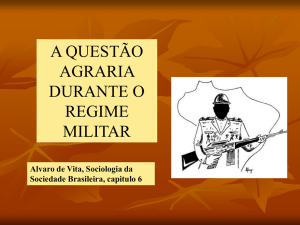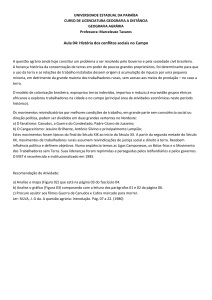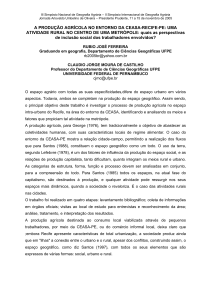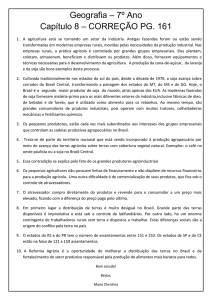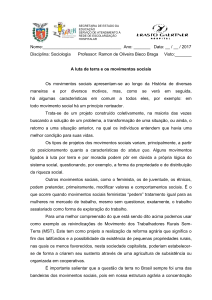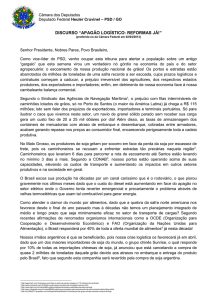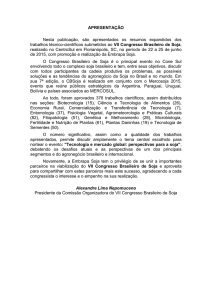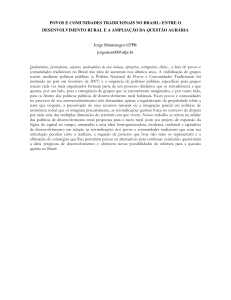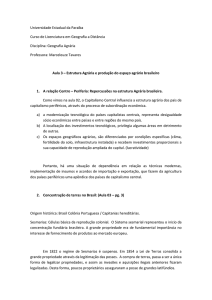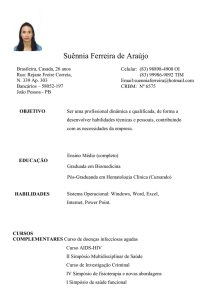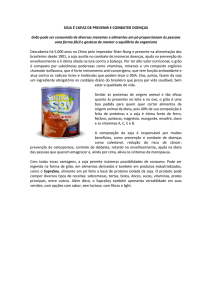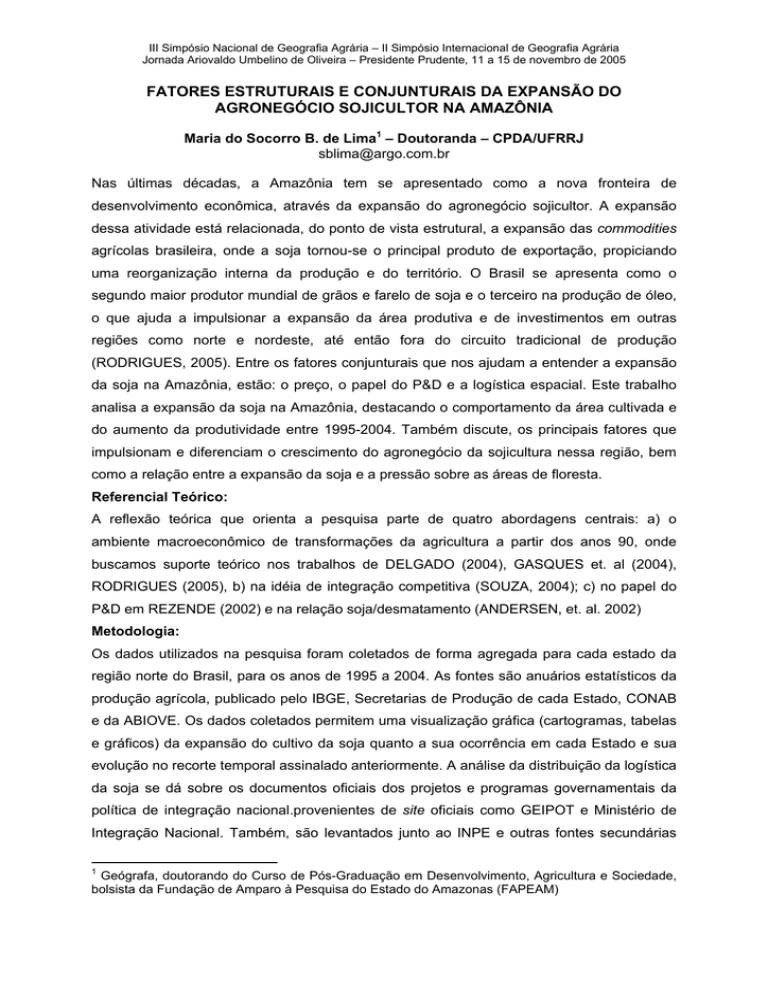
III Simpósio Nacional de Geografia Agrária – II Simpósio Internacional de Geografia Agrária
Jornada Ariovaldo Umbelino de Oliveira – Presidente Prudente, 11 a 15 de novembro de 2005
FATORES ESTRUTURAIS E CONJUNTURAIS DA EXPANSÃO DO
AGRONEGÓCIO SOJICULTOR NA AMAZÔNIA
Maria do Socorro B. de Lima1 – Doutoranda – CPDA/UFRRJ
[email protected]
Nas últimas décadas, a Amazônia tem se apresentado como a nova fronteira de
desenvolvimento econômica, através da expansão do agronegócio sojicultor. A expansão
dessa atividade está relacionada, do ponto de vista estrutural, a expansão das commodities
agrícolas brasileira, onde a soja tornou-se o principal produto de exportação, propiciando
uma reorganização interna da produção e do território. O Brasil se apresenta como o
segundo maior produtor mundial de grãos e farelo de soja e o terceiro na produção de óleo,
o que ajuda a impulsionar a expansão da área produtiva e de investimentos em outras
regiões como norte e nordeste, até então fora do circuito tradicional de produção
(RODRIGUES, 2005). Entre os fatores conjunturais que nos ajudam a entender a expansão
da soja na Amazônia, estão: o preço, o papel do P&D e a logística espacial. Este trabalho
analisa a expansão da soja na Amazônia, destacando o comportamento da área cultivada e
do aumento da produtividade entre 1995-2004. Também discute, os principais fatores que
impulsionam e diferenciam o crescimento do agronegócio da sojicultura nessa região, bem
como a relação entre a expansão da soja e a pressão sobre as áreas de floresta.
Referencial Teórico:
A reflexão teórica que orienta a pesquisa parte de quatro abordagens centrais: a) o
ambiente macroeconômico de transformações da agricultura a partir dos anos 90, onde
buscamos suporte teórico nos trabalhos de DELGADO (2004), GASQUES et. al (2004),
RODRIGUES (2005), b) na idéia de integração competitiva (SOUZA, 2004); c) no papel do
P&D em REZENDE (2002) e na relação soja/desmatamento (ANDERSEN, et. al. 2002)
Metodologia:
Os dados utilizados na pesquisa foram coletados de forma agregada para cada estado da
região norte do Brasil, para os anos de 1995 a 2004. As fontes são anuários estatísticos da
produção agrícola, publicado pelo IBGE, Secretarias de Produção de cada Estado, CONAB
e da ABIOVE. Os dados coletados permitem uma visualização gráfica (cartogramas, tabelas
e gráficos) da expansão do cultivo da soja quanto a sua ocorrência em cada Estado e sua
evolução no recorte temporal assinalado anteriormente. A análise da distribuição da logística
da soja se dá sobre os documentos oficiais dos projetos e programas governamentais da
política de integração nacional.provenientes de site oficiais como GEIPOT e Ministério de
Integração Nacional. Também, são levantados junto ao INPE e outras fontes secundárias
1
Geógrafa, doutorando do Curso de Pós-Graduação em Desenvolvimento, Agricultura e Sociedade,
bolsista da Fundação de Amparo à Pesquisa do Estado do Amazonas (FAPEAM)
III Simpósio Nacional de Geografia Agrária – II Simpósio Internacional de Geografia Agrária
Jornada Ariovaldo Umbelino de Oliveira – Presidente Prudente, 11 a 15 de novembro de 2005
dados referentes às áreas de desmatamento na Amazônia para a série do mesmo período
(1995/2004), buscando se interpretar a relação/soja desmatamento,
Resultados Preliminares:
A expansão da soja na Amazônia está relacionada ao ‘ajustamento constrangido’ da política
macroeconômica brasileira que impõe condições imperiosas de geração de superávits
primários, onde a soja é o principal produto. Sua expansão se dá em contexto de integração
competitiva da região ao circuito produtivo em escala internacional, implicando em um
rearranjo da produção e do território nacional dentro da perspectiva de uma política nacional
de desenvolvimento regional. A logística espacial direcionada pelos eixos de integração
nacional na Amazônia facilita o escoamento desse produto ao mesmo tempo em que
possibilita
a
diminuição
dos
custos
de
transporte
tornado-o
mais
competitivo
internacionalmente. Por outro lado, a pressão dessa expansão está diretamente ou
indiretamente contribuindo para o aumento do desmatamento da floresta.
REFERÊNCIAS BIBLIOGRÁFICAS
ANDERSEN, L. E.; GRANGER, C. W. ; REIS, E. J.; WEINHOLD, D.; WUNDER, S. The
Dynamics of Deflorestation and Economic Growth in the Brazilian Amazon. Cambridge,
2002.
DELGADO, G. C. Questão Agrária Brasileira no Pós Guerra e sua Configuração
Contemporânea. Versão Preliminar. mimeo. 2004.
GASQUES, J. G; REZENDE, G. C. de; VERDE, C. M. V; CONCEIÇÃO, J.C. P. R. da;
CARVALHO, J.C. de S.; SALERNO, M. S. Desempenho e Crescimento do Agronegócio
no Brasil. IPEA. Texto para Discussão 1009, 2004.
SOUZA, A. de O. Diretrizes da Política de Desenvolvimento Regional: o caso do
programa
governamental
“Avança
Brasil”.
Disponível
em
http://www.ucdb.br/coloquio/arquivos/adauto.pdf. Acessado 10/11/2004.
REZENDE, G. C. de. Ocupação Agrícola e Estrutura Agrária no Cerrado: o papel do
preço da terra, dos recursos naturais e da tecnologia IPEA. Texto para discussão nº
913, 2002.
RODRIGUES, J. G. B. Conjuntura da Soja para a Safra de 2004/2005. Boletim Deser, nº.
142, março/2005.p. 11-22. Disponível em http://www.deser.org.br/boletins.asp?id=31.
Acessado em 01/05/2005.
STRUCTURAL AND CONJUNCTURAL FACTORS OF THE EXPANSION OF
SOJICULTOR AGRIBUSINESS IN THE AMAZON
Maria do Socorro B. de Lima2 – Doctorate – CPDA/UFRRJ
[email protected]
In the last decades, the Amazon if has presented as the new borderof economic
development, through the expansion of the sojicultor agribusiness. The expansion of this
2
Geographer, doctorate of the Pós-Graduation Course in Development, Agriculture and Society,
scholarship holder of the Foundation of Support to the Research of the State of Amazon (FAPEAM)
III Simpósio Nacional de Geografia Agrária – II Simpósio Internacional de Geografia Agrária
Jornada Ariovaldo Umbelino de Oliveira – Presidente Prudente, 11 a 15 de novembro de 2005
activity is related, of the structural point of view, the expansion of commodities agriculturists
Brazilian, where the soy became the main product of exportation, propitiating an internal
reorganization of the production and the territory. Brazil if presentsas as bigger world-wide
producer of grains and bran of soy and thirdin the oil production, what it helps to stimulate
the expansion of the productive area and investments in other regions as north and
northeast, until then it are of the traditional circuit of production (RODRIGUES, 2005). It
enters the conjunctural factors that in help tounderstand them the expansion of the soy in the
Amazônia, are: the price, the paper of the P&D and logistic space. This work analyzes the
expansion of the soy in the Amazon, detaching the behavior of the cultivated area and the
increase of the productivity between 1995-2004. Also it argues, the main factors that
stimulate and differentiate the growth of the agribusiness of the sojicultura in this region, as
well as the relation it enters the expansion of the soy and the pressure on the forest areas.
Theoretical Referencial:
The theoretical reflection that guides theresearch has broken of four boardings central
offices: a) the macroeconomic environment of transformations of agriculture from the years
90, where we search theoretical support in the works of DELGADO (2004), GASQUES et. al
(2004), RODRIGUES (2005), b) in the idea of competitive integration (SOUZA, 2004); c) in
the paper of the P&D
in REZENDE (2002)
and
d) in the relation soy/deforestation
(ANDERSEN, L. E. et. all., 2002)
Methodology:
The data used in the research had been collected of form added foreach state of the region
north of Brazil, for the years of 1995 the 2004. The sources are statistical annuls of the
agricultural production, published for IBGE, Secretariats of Production of each State, CONAB
and of the ABIOVE. The collected data allow to a graphical visualization (cartogramas, tables
and graphs) of the expansion of the culture of the soy how muchits occurrence in each State
and its evolution in the designated secular clipping previously. The analysis of the distribution
of the logistic one of the soy if gives on official documents of the projects and governmental
programs of the nacional.provenientes politics of official integration of siteas GEIPOT and
Ministry of National Integration. Also, other referring given secondary sources to the areas of
deforestation in the Amazon for the series of the same period are raised together to the INPE
and (1995/2004), searching if to interpret relation/soy deforestation,
Preliminary Results:
The expansion of the soy in the Amazon is related the 'constrangido adjustment ' of the
Brazilian macroeconomic politics that imposes primary imperious conditions of generation of
superávits, where the soy is the main product. Its expansion if gives in context of competitive
integration of the region to the productive circuit in international scale, implying in a
rearrangement of the production and the domestic territory inside of the perspective of one
III Simpósio Nacional de Geografia Agrária – II Simpósio Internacional de Geografia Agrária
Jornada Ariovaldo Umbelino de Oliveira – Presidente Prudente, 11 a 15 de novembro de 2005
national politics of regional development. The logistic space one directed for the axles of
national integration in the Amazon facilitates the draining of this product at the same time
where it internationally makes possible the reduction of the costs of transport become it more
competitive. However, the pressure of this expansion is directly or indirectly contributing for
the increase ofthe deforestation of the forest.
REFERENCES
ANDERSEN, L. E.; GRANGER, C. W. ; REIS, E. J.; WEINHOLD, D.; WUNDER, S. The
Dynamics of Deflorestation and Economic Growth in the Brazilian Amazon. Cambridge,
2002.
DELGADO, G. C. Questão Agrária Brasileira no Pós Guerra e sua Configuração
Contemporânea. Versão Preliminar. mimeo. 2004.
GASQUES, J. G; REZENDE, G. C. de; VERDE, C. M. V; CONCEIÇÃO, J.C. P. R. da;
CARVALHO, J.C. de S.; SALERNO, M. S. Desempenho e Crescimento do Agronegócio
no Brasil. IPEA. Texto para Discussão 1009, 2004.
SOUZA, A. de O. Diretrizes da Política de Desenvolvimento Regional: o caso do
programa
governamental
“Avança
Brasil”.
Disponível
em
http://www.ucdb.br/coloquio/arquivos/adauto.pdf. Acessado 10/11/2004.
REZENDE, G. C. de. Ocupação Agrícola e Estrutura Agrária no Cerrado: o papel do
preço da terra, dos recursos naturais e da tecnologia IPEA. Texto para discussão nº
913, 2002.
RODRIGUES, J. G. B. Conjuntura da Soja para a Safra de 2004/2005. Boletim Deser, nº.
142, março/2005.p. 11-22. Disponível em http://www.deser.org.br/boletins.asp?id=31.
Acessado em 01/05/2005.

